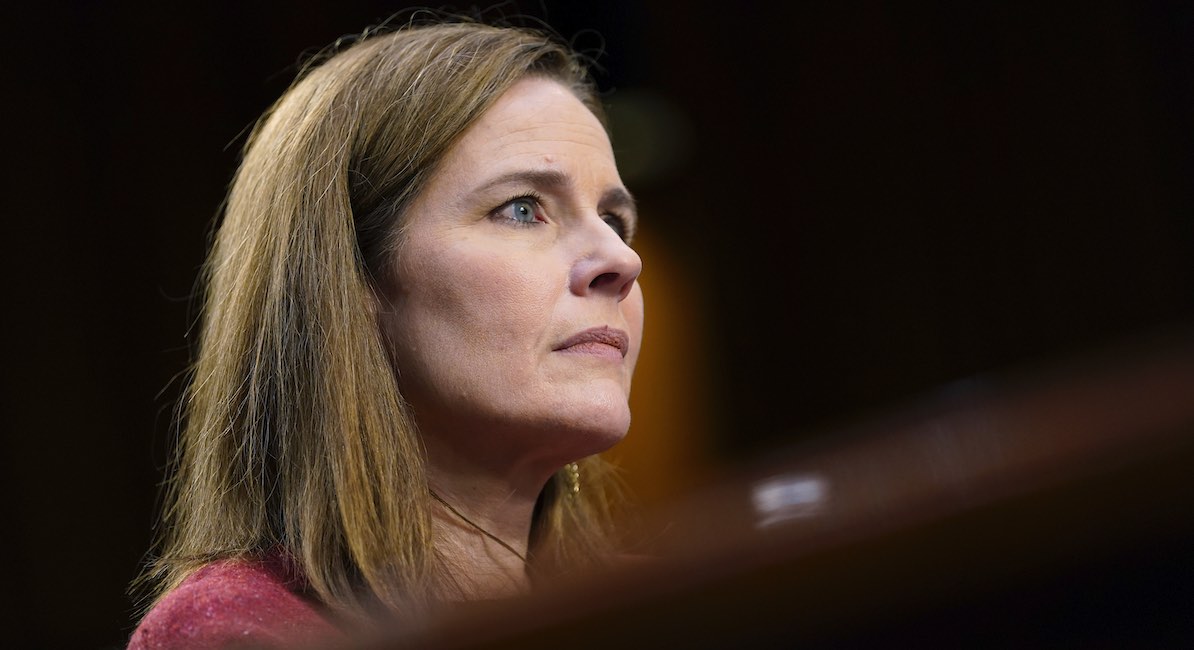(The Daily Signal) Far-left activists sang, cursed, and shouted as they protested numerous political causes outside the home of Supreme Court Justice Amy Coney Barrett [on January 29].
Activists with Our Rights DC marched into the Barrett family’s quiet Virginia neighborhood on Sunday evening, despite a federal law (18 U.S. Code 1507) that forbids picketing or parading “in or near a building or residence occupied or used by such judge, juror, witness, or court officer” with the intent of intimidating or influencing that person.
“Cut her time short,” they chanted as they processed. First they shouted (presumably to Barrett) about the death of Tyre Nichols and racial justice.
“Say his name!” they chanted.
Then they quickly moved on to abortion.
“My body my choice, my body belongs to me,” they sang into megaphones, as one of the activists beat a drum.
WATCH:
Far-left protestors are back at Amy Coney Barrett’s home demonstrating in violation of 18 U.S. code 1507 pic.twitter.com/5r0D2cpryd
— Mary Margaret Olohan (@MaryMargOlohan) January 29, 2023
The Daily Signal repeatedly asked the activists, without response, why they were protesting in the Barrett’s neighborhood. The activists similarly would not address questions about the protest’s effect on Barrett’s seven children (there are many other children who reside in the neighborhood as well).
The activists have been protesting outside the homes of the justices for almost nine months, since the May leak of the draft opinion indicating Roe v. Wade would be overturned. Frequent protesters include Sadie Kuhns, Melissa Barlow, Nikki Enfield, and Nadine Seiler.
Many of these protesters have ties to ShutDownDC and Ruth Sent Us, organizations that have posted the addresses of the Supreme Court justices online, offered bounties for sightings of the justices, and called for continued protesting intended to make the justices uncomfortable with overturning Roe v. Wade.
Only last weekend, The Daily Signal covered a protest at Supreme Court Justice Brett Kavanaugh’s home in Chevy Chase, Maryland. As has been the case in recent months, Kavanaugh’s home was heavily guarded by U.S. Marshals standing between the protesters, who were on the sidewalk, and the house.
Conversely, Barrett’s home did not have U.S. Marshals stationed in front of the house (perhaps because the demonstrations at Barrett’s home are typically smaller than that at Kavanaugh’s). The Daily Signal observed two or three policemen as well as two U.S. Marshals on Sunday. The authorities did not stand in front of the house but largely stood by their vehicles.
After processing around the neighborhood several times, the protesters marched back to their meeting place, a middle school parking lot.
Both Republican Virginia Gov. Glenn Youngkin and former Republican Maryland Gov. Larry Hogan begged the Department of Justice in May to enforce the federal law protecting Supreme Court justices.
The DOJ did not fully respond to the request until June 8—the same day that authorities arrested Nicholas Roske and charged him with attempting to kill Justice Brett Kavanaugh—but refused to discuss whether the protesters had broken the law citing “longstanding policy.”
“We thought there would be more urgency,” Michael Ricci, who served as former Republican Maryland Gov. Larry Hogan’s spokesman, shared with The Daily Signal in a Wednesday phone interview. “In this climate, there are any number of threats, both specific and vague, against public officials. And we thought there would be more urgency about protecting the perimeter of the justices’ homes, and by extension, their neighborhoods.”
Laws in both Maryland and Virginia also prohibit picketing to disrupt or threaten to disrupt that individual’s “tranquility in his home.” The Maryland Attorney General’s Office has reportedly disputed the constitutionality of the state’s law.
And in Virginia, Fairfax County Board of Supervisors Chairman Jeffrey McKay denied Virginia Gov. Glenn Youngkin’s request to establish an expanded security perimeter around the homes of three Supreme Court justices who live in Fairfax County.
Hogan’s office began coordination calls with law enforcement after the governors sent their letter to the DOJ, according to Ricci. That coordination included state law enforcement, Montgomery County law enforcement, and then Supreme Court law enforcement.
“To the extent that federal law enforcement was involved, they were more focused on getting the justices to and from their homes, and weren’t as focused on the immediate community,” he explained. “So it was clear to us we were not going to get a lot of backup, in terms of protecting the area and keeping the peace on the streets, so to speak. So that really became a state, county operation.”
On July 2, the Supreme Court’s chief security officer, Gail Curley, asked top Maryland and Virginia officials to enforce their laws protecting the justices. Since then, law enforcement have continued to stand outside the justices’ homes as the protests take place.
Youngkin’s office continues to monitor the situation and has directed Virginia State Police to be at the ready and in “constant coordination” with local authorities, spokesman Christian Martinez told The Daily Signal on Tuesday.
“Governor Youngkin will continue to push for every resource of federal law enforcement, including the U.S. Marshals, to be involved while the Justices continue to be denied the right to live peacefully in their homes,” he said.
And until now, Maryland has used county statues and laws on disorderly conduct and noise ordinances to keep the peace.
Editor’s Note: This article was published at the Daily Signal and is reprinted here with permission.








